 The Dot Records Story, Part 2
The Dot Records Story, Part 2
By Mike Callahan and David Edwards
Last update: November 10, 1999
Continued from previous page...
Independent Producers, Rock & Roll, and Other Necessary Evils, 1956-1959
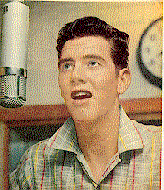 Also in 1956 Randy Wood moved his company from Tennessee to Hollywood, and at the same time
moved the company away from recording rhythm & blues music toward straight pop. From this point on,
Dot was rarely a musical innovator in areas other than pop, and when they released R&B or R&R, they
usually obtained the masters from others. Apparently, with the cover record era coming to an end in
1956, Wood found a better way to get into the rock and roll market: buy or lease the masters from
independent producers. One of the first of these songs was Lee Hazlewood's production of his own
composition, "The Fool," with Sanford Clark singing. The record was recorded in a small studio under
primitive conditions in Phoenix, Hazlewood's base of operations. Originally issued on MCI 1003,
Hazlewood had written the song as a country tune, but to his surprise, none of the country distributors
bought it, probably because of the obviously-non-country guitar riff that Al Casey played. But it broke
pop, and Wood picked up the master and reissued it as Dot 15481, and it made #7 nationally. Although
Clark had one more chart record ("A Cheat," Dot 15516), he felt ill-at-ease with the material Randy
Wood was asking him to record, and soon left the label. Hazelwood, meanwhile, continued in Phoenix
recording Al Casey and a Jamie Records guitarist named Duane Eddy. Eventually, Hazelwood's
songwriting prowess led him west, where in the 1960s he had success writing for (and singing with)
Nancy Sinatra. In fact, it was Duane Eddy's prominent bass in the Hazelwood tune "These Boots Are
Made For Walkin'" that put Nancy on the musical map in 1966.
Also in 1956 Randy Wood moved his company from Tennessee to Hollywood, and at the same time
moved the company away from recording rhythm & blues music toward straight pop. From this point on,
Dot was rarely a musical innovator in areas other than pop, and when they released R&B or R&R, they
usually obtained the masters from others. Apparently, with the cover record era coming to an end in
1956, Wood found a better way to get into the rock and roll market: buy or lease the masters from
independent producers. One of the first of these songs was Lee Hazlewood's production of his own
composition, "The Fool," with Sanford Clark singing. The record was recorded in a small studio under
primitive conditions in Phoenix, Hazlewood's base of operations. Originally issued on MCI 1003,
Hazlewood had written the song as a country tune, but to his surprise, none of the country distributors
bought it, probably because of the obviously-non-country guitar riff that Al Casey played. But it broke
pop, and Wood picked up the master and reissued it as Dot 15481, and it made #7 nationally. Although
Clark had one more chart record ("A Cheat," Dot 15516), he felt ill-at-ease with the material Randy
Wood was asking him to record, and soon left the label. Hazelwood, meanwhile, continued in Phoenix
recording Al Casey and a Jamie Records guitarist named Duane Eddy. Eventually, Hazelwood's
songwriting prowess led him west, where in the 1960s he had success writing for (and singing with)
Nancy Sinatra. In fact, it was Duane Eddy's prominent bass in the Hazelwood tune "These Boots Are
Made For Walkin'" that put Nancy on the musical map in 1966.
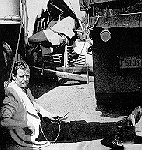 The mid-to-late-1950s were prime time for novelty songs. In addition to the Jim Lowe novelties, in 1956
Dot signed a truck driver from Oakland named Jimmy Drake, based on Wood's hearing a warped demo
of "Transfusion." Recording under the alias Nervous Norvus, Drake's "Transfusion" (Dot 15470),
complete with car crash sound effects, made top-10, although it was banned on many radio stations both
in the US and in the UK. The six sides Drake cut for Dot as Nervous Norvus, including "Dig" (the flip of
"Transfusion"), "Ape Call"/"Wild Dog of Kentucky" (Dot 15485), and "The Fang"/"The Bullfrog" (Dot
15500), have become novelty "cult classics" and are still featured on novelty radio shows. "Ape Call,"
featuring Drake's friend Red Blanchard's Tarzan-like calls, also made the top-25 in 1956. After a short
moment of fame, Drake recorded for a few other labels, then went back to obscurity.
The mid-to-late-1950s were prime time for novelty songs. In addition to the Jim Lowe novelties, in 1956
Dot signed a truck driver from Oakland named Jimmy Drake, based on Wood's hearing a warped demo
of "Transfusion." Recording under the alias Nervous Norvus, Drake's "Transfusion" (Dot 15470),
complete with car crash sound effects, made top-10, although it was banned on many radio stations both
in the US and in the UK. The six sides Drake cut for Dot as Nervous Norvus, including "Dig" (the flip of
"Transfusion"), "Ape Call"/"Wild Dog of Kentucky" (Dot 15485), and "The Fang"/"The Bullfrog" (Dot
15500), have become novelty "cult classics" and are still featured on novelty radio shows. "Ape Call,"
featuring Drake's friend Red Blanchard's Tarzan-like calls, also made the top-25 in 1956. After a short
moment of fame, Drake recorded for a few other labels, then went back to obscurity.
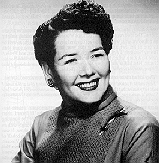 In early 1957, Randy Wood obtained a record from the Fabor label's owner, Fabor Robison (sometimes
spelled Robinson). Bonnie Buckingham had been born in Seattle 33 years earlier, and had spent some
time fronting her own band in Seattle as Bonnie Tutmarc (her married name), playing western swing,
jazz, and anything else that came along. It was Robison that suggested that she change her name, and
it was Bonnie that suggested "Bonnie Guitar." She was hired as a studio guitarist for the Fabor record
label in California, and also began to record her own records. When a demo tape of Ned Miller's
composition, "Dark Moon" came in, she knew the song would be perfect for her, and although Robison
was going to give the song to Dorsey Burnette, Bonnie struck a deal with him to get the song. Robison
released it as Fabor 4018 (with Miller himself playing acoustic guitar), then shopped the record to Dot,
who reissued it as Dot 15550. It made #6 nationally, even though Gale Storm covered it (her version
made #4, making it a double top-10 for Randy Wood). Bonnie's followup, "Mister Fire Eyes" (Dot 15612),
was a collaboration with Ned Miller. It made top-15 on the country charts, but the hits stopped there,
mainly because Fabor Robison and Bonnie Guitar had a disagreement over her career and she quit.
She went back to Seattle and co-founded Dolton Records (Fleetwoods, Ventures, Vic Dana, etc.) .
Eventually, she sold Dolton to Liberty, and went back to recording with Dot in 1966. She was on the
country charts from 1966 to 1989.
In early 1957, Randy Wood obtained a record from the Fabor label's owner, Fabor Robison (sometimes
spelled Robinson). Bonnie Buckingham had been born in Seattle 33 years earlier, and had spent some
time fronting her own band in Seattle as Bonnie Tutmarc (her married name), playing western swing,
jazz, and anything else that came along. It was Robison that suggested that she change her name, and
it was Bonnie that suggested "Bonnie Guitar." She was hired as a studio guitarist for the Fabor record
label in California, and also began to record her own records. When a demo tape of Ned Miller's
composition, "Dark Moon" came in, she knew the song would be perfect for her, and although Robison
was going to give the song to Dorsey Burnette, Bonnie struck a deal with him to get the song. Robison
released it as Fabor 4018 (with Miller himself playing acoustic guitar), then shopped the record to Dot,
who reissued it as Dot 15550. It made #6 nationally, even though Gale Storm covered it (her version
made #4, making it a double top-10 for Randy Wood). Bonnie's followup, "Mister Fire Eyes" (Dot 15612),
was a collaboration with Ned Miller. It made top-15 on the country charts, but the hits stopped there,
mainly because Fabor Robison and Bonnie Guitar had a disagreement over her career and she quit.
She went back to Seattle and co-founded Dolton Records (Fleetwoods, Ventures, Vic Dana, etc.) .
Eventually, she sold Dolton to Liberty, and went back to recording with Dot in 1966. She was on the
country charts from 1966 to 1989.
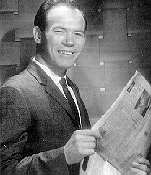 About the same time Wood picked up "Dark Moon," he also got a record called "From a Jack to a King"
from Robison, sung by its writer, Ned Miller, who had penned "Dark Moon." Dot issued it as Dot 15601 in
1957, but it did nothing. It was five years later that Miller persuaded Robison to reissue the song on
Fabor 114, and it went to #2 country and #6 pop. Miller, from the Salt Lake City area, had worked as a
pipe fitter and installed air conditioners before his songwriting talent brought him to the attention of Fabor
Robison. Quite stage-shy, Miller preferred to write songs to be recorded by others, and rarely made
appearances. His other songwriting successes included "Do What You Do Do Well" and "Invisible
Tears." He didn't get around to doing his own version of "Dark Moon" until the early 1960s, when he
recorded it for Capitol.
About the same time Wood picked up "Dark Moon," he also got a record called "From a Jack to a King"
from Robison, sung by its writer, Ned Miller, who had penned "Dark Moon." Dot issued it as Dot 15601 in
1957, but it did nothing. It was five years later that Miller persuaded Robison to reissue the song on
Fabor 114, and it went to #2 country and #6 pop. Miller, from the Salt Lake City area, had worked as a
pipe fitter and installed air conditioners before his songwriting talent brought him to the attention of Fabor
Robison. Quite stage-shy, Miller preferred to write songs to be recorded by others, and rarely made
appearances. His other songwriting successes included "Do What You Do Do Well" and "Invisible
Tears." He didn't get around to doing his own version of "Dark Moon" until the early 1960s, when he
recorded it for Capitol.
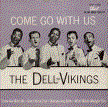 Also in 1957, Wood obtained a master from the Fee Bee record company in Pittsburgh.
The Del
Vikings were group that formed in 1955 when the members were in the US Air Force. They were
Corinthian "Krips" Johnson, Norman Wright, Donald "Gus" Backus, David Lerchey, and Clarence Quick.
They were one of the first racially integrated rock and roll groups, as Johnson, Wright, and Quick are
black, and Backus and Lerchey white. They had earlier recorded for the Luniverse label, then Fee Bee.
The original recording of "Come Go With Me" appeared on Fee Bee 205 in 1956. The song was a big hit
in Pittsburgh and Dot purchased the recording, along with their other Fee Bee recordings. Dot released
"Come Go With Me" nationally (Dot 15538), and signed the group to the label. After "Come Go With Me"
was a big success on Dot, Mercury records tried to get the group to sign with them. The way Mercury
figured it, since all the members of the group signing with Dot were under 21, except lead singer Krips
Johnson, the contract they signed was not binding. All the group members except Johnson left for the
big money Mercury offered them. Johnson stayed with Dot and recruited new members, including Chuck
Jackson (later a hit pop/soul artist for the Wand label). Dot reissued another Fee Bee side, "Whispering
Bells" (Fee Bee 214, Dot 15592) as the followup, billed as "The Dell-Vikings featuring Krips Johnson,"
while Mercury countered with a new recording, "Cool Shake" (Mercury 71132), billed as "The Del Vikings
featuring Gus Backus." Both charted at the same time during summer 1957, with "Whispering Bells"
making #9 and "Cool Shake" making #12. The whole mess ended up in court, and by December,
Mercury was given all rights to the group. Dot did maintain ownership of the original Fee Bee recordings.
The court case didn't enhance either group's career, as neither ever charted again. Not prone to hasty
action, Dot procrastinated until 1966 before they issued an album by the group (Dot DLP-3695), mostly
made up of previously released material from Fee Bee. By the time the Dot album came out, the
Dell-Vikings/Del Vikings were long past their hit-making days and the album sold poorly, making it a very
collectable record today.
Also in 1957, Wood obtained a master from the Fee Bee record company in Pittsburgh.
The Del
Vikings were group that formed in 1955 when the members were in the US Air Force. They were
Corinthian "Krips" Johnson, Norman Wright, Donald "Gus" Backus, David Lerchey, and Clarence Quick.
They were one of the first racially integrated rock and roll groups, as Johnson, Wright, and Quick are
black, and Backus and Lerchey white. They had earlier recorded for the Luniverse label, then Fee Bee.
The original recording of "Come Go With Me" appeared on Fee Bee 205 in 1956. The song was a big hit
in Pittsburgh and Dot purchased the recording, along with their other Fee Bee recordings. Dot released
"Come Go With Me" nationally (Dot 15538), and signed the group to the label. After "Come Go With Me"
was a big success on Dot, Mercury records tried to get the group to sign with them. The way Mercury
figured it, since all the members of the group signing with Dot were under 21, except lead singer Krips
Johnson, the contract they signed was not binding. All the group members except Johnson left for the
big money Mercury offered them. Johnson stayed with Dot and recruited new members, including Chuck
Jackson (later a hit pop/soul artist for the Wand label). Dot reissued another Fee Bee side, "Whispering
Bells" (Fee Bee 214, Dot 15592) as the followup, billed as "The Dell-Vikings featuring Krips Johnson,"
while Mercury countered with a new recording, "Cool Shake" (Mercury 71132), billed as "The Del Vikings
featuring Gus Backus." Both charted at the same time during summer 1957, with "Whispering Bells"
making #9 and "Cool Shake" making #12. The whole mess ended up in court, and by December,
Mercury was given all rights to the group. Dot did maintain ownership of the original Fee Bee recordings.
The court case didn't enhance either group's career, as neither ever charted again. Not prone to hasty
action, Dot procrastinated until 1966 before they issued an album by the group (Dot DLP-3695), mostly
made up of previously released material from Fee Bee. By the time the Dot album came out, the
Dell-Vikings/Del Vikings were long past their hit-making days and the album sold poorly, making it a very
collectable record today.
Another master obtained from an independent producer in the 1950s included a #49 hit, "Henrietta," by
Jimmy Dee and the Offbeats (Dot 15664). The record had originally appeared on Bob Tanner's TNT
label out of Austin, Texas (TNT 148, 1957). At the time it was recorded, Dee and his group were regular
performers at the Tiffany Lounge in San Antonio. The record has an interesting historical footnote, as it
was the first record Bob Dylan ever bought. Jimmy Dee (Fore) later left music and ended up managing
the Houston Astrodome.
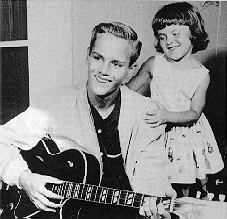 Robin Luke, a Los Angeles-born transplant to Hawaii, recorded "Susie Darlin" in a bedroom and
adjoining bathroom (echo chamber), with mono-to-mono overdubs and percussion courtesy of a couple
of sticks hitting a fountain pen in Bob Bertram's pocket. The inspiration for "Susie Darlin'" was said to be
Robin Luke's little sister, Susie. Art Freeman, a Dot distributor from Cleveland, heard the record in
Hawaii on his honeymoon and brought it back to Wood. It was reissued from its original Bertram
International 206 as Dot 15781.
Robin Luke, a Los Angeles-born transplant to Hawaii, recorded "Susie Darlin" in a bedroom and
adjoining bathroom (echo chamber), with mono-to-mono overdubs and percussion courtesy of a couple
of sticks hitting a fountain pen in Bob Bertram's pocket. The inspiration for "Susie Darlin'" was said to be
Robin Luke's little sister, Susie. Art Freeman, a Dot distributor from Cleveland, heard the record in
Hawaii on his honeymoon and brought it back to Wood. It was reissued from its original Bertram
International 206 as Dot 15781. 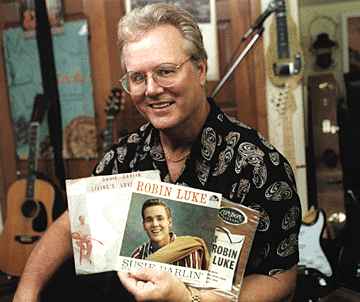 Several followups on Dot were excellent, but Luke failed to recapture
the chart smash of "Susie Darlin'," which hit #5 nationally. In bringing over the masters from Hawaii,
Wood was faced with union problems, as Bertram's label was non-union. Wood re-recorded "Susie
Darlin'" with union musicians and singers backing Luke, but it wasn't the same, so Randy surreptitiously
slipped the original master to the pressing plant. Although we haven't heard the Dot remake (it was
unreleased), the extra vocals Dot added to "Five Minutes More" can be compared on Bear Family's vinyl
(original) and CD (overdub) versions of their Robin Luke packages (see related albums discography).
Robin Luke eventually became a university professor.
Several followups on Dot were excellent, but Luke failed to recapture
the chart smash of "Susie Darlin'," which hit #5 nationally. In bringing over the masters from Hawaii,
Wood was faced with union problems, as Bertram's label was non-union. Wood re-recorded "Susie
Darlin'" with union musicians and singers backing Luke, but it wasn't the same, so Randy surreptitiously
slipped the original master to the pressing plant. Although we haven't heard the Dot remake (it was
unreleased), the extra vocals Dot added to "Five Minutes More" can be compared on Bear Family's vinyl
(original) and CD (overdub) versions of their Robin Luke packages (see related albums discography).
Robin Luke eventually became a university professor.
Other rock and roll masters purchased in the late 1950s didn't fare as well in the charts, but included
some interesting artists, such as Mickey Gilley, Ray Campi, Leroy Van Dyke, Bob Denton, Jimmy Ringo,
Dick Lory, Danny Wolfe, Gene Brown, Keith Courvale, Niki Sullivan (of Buddy Holly's Crickets), Kay Cee
Jones, Tommy Danton, Joyce Paul, Billy Adams, the Five Bops, and Ray Sharpe. Generally, Randy
Wood gave a lot of unknown, would-be stars a fighting chance to succeed, with his excellent national
promotion and distribution. Even Milwaukee Braves pitcher Lew Burdette was signed for a disc ("Three
Strikes and You're Out", Dot 15672), after being the pitching hero of the 1957 World Series. One of the
interesting aspects of this relationship with independent producers, however, was that an agreement
was usually struck for one or two records at a time. If the first ones stiffed, the artists were history with
Dot, even though a few of these artists became better known later with other labels.
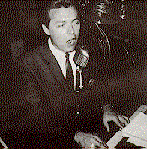 Mickey Gilley, of course, is Jerry Lee Lewis' cousin, and the piano style was similar. He had one single
for Dot, "Call Me Shorty"/"Come On Baby" (Dot 15706) in 1958, but that was all. He spent a lot of time in
the 1950s and 1960s looking for success without finding much. By the start of the 1970s, he had had
only one minor country charter ("Now I Can Live Again", Paula 1200 in 1968) to show for his trouble. He
founded Gilley's, a nightclub in Houston, along with Sherwood Cryer in 1971, and played there often. By
1974, he began to be a regular on the national country charts, racking up almost 50 sides by 1989.
Gilley's nightclub was so well known that it was featured in the 1980 film Urban Cowboy.
Coincidently, the year the nightclub closed, 1989, was his last year on the charts.
Mickey Gilley, of course, is Jerry Lee Lewis' cousin, and the piano style was similar. He had one single
for Dot, "Call Me Shorty"/"Come On Baby" (Dot 15706) in 1958, but that was all. He spent a lot of time in
the 1950s and 1960s looking for success without finding much. By the start of the 1970s, he had had
only one minor country charter ("Now I Can Live Again", Paula 1200 in 1968) to show for his trouble. He
founded Gilley's, a nightclub in Houston, along with Sherwood Cryer in 1971, and played there often. By
1974, he began to be a regular on the national country charts, racking up almost 50 sides by 1989.
Gilley's nightclub was so well known that it was featured in the 1980 film Urban Cowboy.
Coincidently, the year the nightclub closed, 1989, was his last year on the charts.
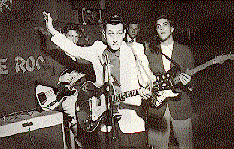 Ray Campi was another of 1950s music's minor leaguers who gained some fame decades later. Campi
had been leader of a country band since 1948, billing himself as Rambling Ray. In 1957, he recorded "It
Ain't Me"/"Give That Love To Me" (Dot 15617) in Dallas, and it promptly sank without a trace. When the
rockabilly retro craze hit in the 1980s, Ray Campi was still performing, and became one of the best
known performers in that genre, having both old material reissued and recording new albums. Today, "It
Ain't Me," the single they almost couldn't give away in 1957, brings big bucks on the collectors market.
Ray Campi was another of 1950s music's minor leaguers who gained some fame decades later. Campi
had been leader of a country band since 1948, billing himself as Rambling Ray. In 1957, he recorded "It
Ain't Me"/"Give That Love To Me" (Dot 15617) in Dallas, and it promptly sank without a trace. When the
rockabilly retro craze hit in the 1980s, Ray Campi was still performing, and became one of the best
known performers in that genre, having both old material reissued and recording new albums. Today, "It
Ain't Me," the single they almost couldn't give away in 1957, brings big bucks on the collectors market.
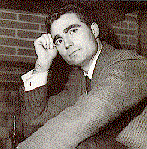 Leroy Van Dyke had served in the army in the Korean "conflict," and while there wrote a song based on
his cousin's occupation. "The Auctioneer" won him an Amateur Hour victory and a spot in the national
top 20 (#9 country) in early 1957 (Dot 15503). His success bought him a bit more patience with Dot than
the usual new artist, and he released four other unsuccessful singles before the curtain came down. His
real success was several years in the future, with the #1 country record "Walk On By" (Mercury 71834)
in late 1961 that established him on the counrty charts. He had 17 other records on the country charts
between 1962 and 1977. Ironically, it was back with Dot Records in 1975-77 that he finished his chart
career.
Leroy Van Dyke had served in the army in the Korean "conflict," and while there wrote a song based on
his cousin's occupation. "The Auctioneer" won him an Amateur Hour victory and a spot in the national
top 20 (#9 country) in early 1957 (Dot 15503). His success bought him a bit more patience with Dot than
the usual new artist, and he released four other unsuccessful singles before the curtain came down. His
real success was several years in the future, with the #1 country record "Walk On By" (Mercury 71834)
in late 1961 that established him on the counrty charts. He had 17 other records on the country charts
between 1962 and 1977. Ironically, it was back with Dot Records in 1975-77 that he finished his chart
career.
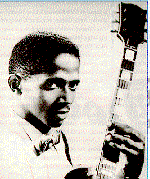 Ray Sharpe's "That's the Way I Feel" was issued on a new subsidiary label, Hamilton,
which was started in 1958 (Hamilton 50002). The label was named for Christine Hamilton, Randy
Wood's Director of Operations at Dot. For several years, Hamilton was used sporadically for issuing
singles, primarily rockabilly or R&B singles that didn't fit the pop mold. The label was converted to an
album reissue label in 1964 for budget reissues of Dot albums (see accompanying discography).
Sharpe, who was characterized by producer Major Bill Smith as "the greatest white-sounding black dude
ever," grew up in Fort Worth, Texas.
Ray Sharpe's "That's the Way I Feel" was issued on a new subsidiary label, Hamilton,
which was started in 1958 (Hamilton 50002). The label was named for Christine Hamilton, Randy
Wood's Director of Operations at Dot. For several years, Hamilton was used sporadically for issuing
singles, primarily rockabilly or R&B singles that didn't fit the pop mold. The label was converted to an
album reissue label in 1964 for budget reissues of Dot albums (see accompanying discography).
Sharpe, who was characterized by producer Major Bill Smith as "the greatest white-sounding black dude
ever," grew up in Fort Worth, Texas. 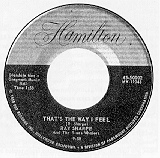 He cut a demo of "That's the Way I Feel" at Artie Glenn's studio in Fort Worth, and Glenn
(whose claim to fame was as writer of "Crying in the Chapel") sent the tape around to people in the
industry, including Lee Hazelwood in Phoenix. Hazlewood rerecorded the song and peddled it to Dot,
who issued it on Hamilton. It didn't sell at all, so Dot took a pass on further product. Sharpe later
recorded "Linda Lu" for Hazelwood, and Lee sent it to Jamie Records in Philadelphia, the label that was
handling Duane Eddy's hits. Backed by Al Casey and Duane Eddy on guitars, "Linda Lu" made #46
(Jamie 1128) in the summer of 1959. Dot reissued "That's The Way I Feel" in 1959 (Dot 15974) after the
success of "Linda Lu," but to no avail.
He cut a demo of "That's the Way I Feel" at Artie Glenn's studio in Fort Worth, and Glenn
(whose claim to fame was as writer of "Crying in the Chapel") sent the tape around to people in the
industry, including Lee Hazelwood in Phoenix. Hazlewood rerecorded the song and peddled it to Dot,
who issued it on Hamilton. It didn't sell at all, so Dot took a pass on further product. Sharpe later
recorded "Linda Lu" for Hazelwood, and Lee sent it to Jamie Records in Philadelphia, the label that was
handling Duane Eddy's hits. Backed by Al Casey and Duane Eddy on guitars, "Linda Lu" made #46
(Jamie 1128) in the summer of 1959. Dot reissued "That's The Way I Feel" in 1959 (Dot 15974) after the
success of "Linda Lu," but to no avail.
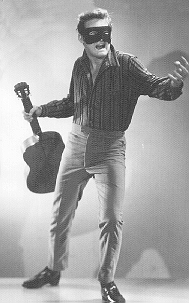 Then, of course, there was "The Phantom." Marty Lott, a country music guitarist, was impressed by the
music explosion called Elvis Presley, and it helped him find his "true self" as a screaming rockabilly
artist. He recorded "Love Me" in Mobile in 1958, and in a 1980 interview with Derek Glenister, Lott
recalls the recording session this way: "I didn't yell on the first take, but I yelled on the second, and blew
one of the controls off the wall.... I'm telling you, It was wild. The drummer lost one of his sticks, the
piano player screamed and knocked his stool over, the guitar player's glasses were hanging sideways
over his eyes..." This bundle of energy was pitched to ... PAT BOONE!! Boone, who has always
confessed to a liking of rock and roll, put it on his own label, and eventually it was picked up by Dot (Dot
16056). Although it didn't chart, it remains a rockabilly classic, if nothing else than for sheer energy.
Lott's "The Phantom" persona wore a black Halloween mask years before Orion (Jimmy Ellis) did it in
the seventies.
Then, of course, there was "The Phantom." Marty Lott, a country music guitarist, was impressed by the
music explosion called Elvis Presley, and it helped him find his "true self" as a screaming rockabilly
artist. He recorded "Love Me" in Mobile in 1958, and in a 1980 interview with Derek Glenister, Lott
recalls the recording session this way: "I didn't yell on the first take, but I yelled on the second, and blew
one of the controls off the wall.... I'm telling you, It was wild. The drummer lost one of his sticks, the
piano player screamed and knocked his stool over, the guitar player's glasses were hanging sideways
over his eyes..." This bundle of energy was pitched to ... PAT BOONE!! Boone, who has always
confessed to a liking of rock and roll, put it on his own label, and eventually it was picked up by Dot (Dot
16056). Although it didn't chart, it remains a rockabilly classic, if nothing else than for sheer energy.
Lott's "The Phantom" persona wore a black Halloween mask years before Orion (Jimmy Ellis) did it in
the seventies.
There are not a lot of high-priced collectable albums on Dot, although early singles are quite rare. The
rarest album on the label is DLP-3154, Poetry For the Beat Generation by Jack Kerouac with
background music by Steve Allen. The reason the record is so rare is because some months after it was
recorded, and shortly before it was to be placed on sale, Randy Wood stopped both pressing and
distribution, declaring that certain passages were "in bad taste," certain lines "off color." As reported in
Variety magazine, he would not permit his children to listen to it, and that "his diskery would never
distribute a product that's not clean family entertainment." Prior to the actual release, 130 of the albums
were distributed to reviewers and others, so the record does exist. After Dot refused to release the
recording, it was released by the Hanover label, as HML-5000.
Continued on next page...
 The Dot Records Story, Part 2
The Dot Records Story, Part 2 Also in 1956 Randy Wood moved his company from Tennessee to Hollywood, and at the same time
moved the company away from recording rhythm & blues music toward straight pop. From this point on,
Dot was rarely a musical innovator in areas other than pop, and when they released R&B or R&R, they
usually obtained the masters from others. Apparently, with the cover record era coming to an end in
1956, Wood found a better way to get into the rock and roll market: buy or lease the masters from
independent producers. One of the first of these songs was Lee Hazlewood's production of his own
composition, "The Fool," with Sanford Clark singing. The record was recorded in a small studio under
primitive conditions in Phoenix, Hazlewood's base of operations. Originally issued on MCI 1003,
Hazlewood had written the song as a country tune, but to his surprise, none of the country distributors
bought it, probably because of the obviously-non-country guitar riff that Al Casey played. But it broke
pop, and Wood picked up the master and reissued it as Dot 15481, and it made #7 nationally. Although
Clark had one more chart record ("A Cheat," Dot 15516), he felt ill-at-ease with the material Randy
Wood was asking him to record, and soon left the label. Hazelwood, meanwhile, continued in Phoenix
recording Al Casey and a Jamie Records guitarist named Duane Eddy. Eventually, Hazelwood's
songwriting prowess led him west, where in the 1960s he had success writing for (and singing with)
Nancy Sinatra. In fact, it was Duane Eddy's prominent bass in the Hazelwood tune "These Boots Are
Made For Walkin'" that put Nancy on the musical map in 1966.
Also in 1956 Randy Wood moved his company from Tennessee to Hollywood, and at the same time
moved the company away from recording rhythm & blues music toward straight pop. From this point on,
Dot was rarely a musical innovator in areas other than pop, and when they released R&B or R&R, they
usually obtained the masters from others. Apparently, with the cover record era coming to an end in
1956, Wood found a better way to get into the rock and roll market: buy or lease the masters from
independent producers. One of the first of these songs was Lee Hazlewood's production of his own
composition, "The Fool," with Sanford Clark singing. The record was recorded in a small studio under
primitive conditions in Phoenix, Hazlewood's base of operations. Originally issued on MCI 1003,
Hazlewood had written the song as a country tune, but to his surprise, none of the country distributors
bought it, probably because of the obviously-non-country guitar riff that Al Casey played. But it broke
pop, and Wood picked up the master and reissued it as Dot 15481, and it made #7 nationally. Although
Clark had one more chart record ("A Cheat," Dot 15516), he felt ill-at-ease with the material Randy
Wood was asking him to record, and soon left the label. Hazelwood, meanwhile, continued in Phoenix
recording Al Casey and a Jamie Records guitarist named Duane Eddy. Eventually, Hazelwood's
songwriting prowess led him west, where in the 1960s he had success writing for (and singing with)
Nancy Sinatra. In fact, it was Duane Eddy's prominent bass in the Hazelwood tune "These Boots Are
Made For Walkin'" that put Nancy on the musical map in 1966.
 The mid-to-late-1950s were prime time for novelty songs. In addition to the Jim Lowe novelties, in 1956
Dot signed a truck driver from Oakland named Jimmy Drake, based on Wood's hearing a warped demo
of "Transfusion." Recording under the alias Nervous Norvus, Drake's "Transfusion" (Dot 15470),
complete with car crash sound effects, made top-10, although it was banned on many radio stations both
in the US and in the UK. The six sides Drake cut for Dot as Nervous Norvus, including "Dig" (the flip of
"Transfusion"), "Ape Call"/"Wild Dog of Kentucky" (Dot 15485), and "The Fang"/"The Bullfrog" (Dot
15500), have become novelty "cult classics" and are still featured on novelty radio shows. "Ape Call,"
featuring Drake's friend Red Blanchard's Tarzan-like calls, also made the top-25 in 1956. After a short
moment of fame, Drake recorded for a few other labels, then went back to obscurity.
The mid-to-late-1950s were prime time for novelty songs. In addition to the Jim Lowe novelties, in 1956
Dot signed a truck driver from Oakland named Jimmy Drake, based on Wood's hearing a warped demo
of "Transfusion." Recording under the alias Nervous Norvus, Drake's "Transfusion" (Dot 15470),
complete with car crash sound effects, made top-10, although it was banned on many radio stations both
in the US and in the UK. The six sides Drake cut for Dot as Nervous Norvus, including "Dig" (the flip of
"Transfusion"), "Ape Call"/"Wild Dog of Kentucky" (Dot 15485), and "The Fang"/"The Bullfrog" (Dot
15500), have become novelty "cult classics" and are still featured on novelty radio shows. "Ape Call,"
featuring Drake's friend Red Blanchard's Tarzan-like calls, also made the top-25 in 1956. After a short
moment of fame, Drake recorded for a few other labels, then went back to obscurity.
 In early 1957, Randy Wood obtained a record from the Fabor label's owner, Fabor Robison (sometimes
spelled Robinson). Bonnie Buckingham had been born in Seattle 33 years earlier, and had spent some
time fronting her own band in Seattle as Bonnie Tutmarc (her married name), playing western swing,
jazz, and anything else that came along. It was Robison that suggested that she change her name, and
it was Bonnie that suggested "Bonnie Guitar." She was hired as a studio guitarist for the Fabor record
label in California, and also began to record her own records. When a demo tape of Ned Miller's
composition, "Dark Moon" came in, she knew the song would be perfect for her, and although Robison
was going to give the song to Dorsey Burnette, Bonnie struck a deal with him to get the song. Robison
released it as Fabor 4018 (with Miller himself playing acoustic guitar), then shopped the record to Dot,
who reissued it as Dot 15550. It made #6 nationally, even though Gale Storm covered it (her version
made #4, making it a double top-10 for Randy Wood). Bonnie's followup, "Mister Fire Eyes" (Dot 15612),
was a collaboration with Ned Miller. It made top-15 on the country charts, but the hits stopped there,
mainly because Fabor Robison and Bonnie Guitar had a disagreement over her career and she quit.
She went back to Seattle and co-founded Dolton Records (Fleetwoods, Ventures, Vic Dana, etc.) .
Eventually, she sold Dolton to Liberty, and went back to recording with Dot in 1966. She was on the
country charts from 1966 to 1989.
In early 1957, Randy Wood obtained a record from the Fabor label's owner, Fabor Robison (sometimes
spelled Robinson). Bonnie Buckingham had been born in Seattle 33 years earlier, and had spent some
time fronting her own band in Seattle as Bonnie Tutmarc (her married name), playing western swing,
jazz, and anything else that came along. It was Robison that suggested that she change her name, and
it was Bonnie that suggested "Bonnie Guitar." She was hired as a studio guitarist for the Fabor record
label in California, and also began to record her own records. When a demo tape of Ned Miller's
composition, "Dark Moon" came in, she knew the song would be perfect for her, and although Robison
was going to give the song to Dorsey Burnette, Bonnie struck a deal with him to get the song. Robison
released it as Fabor 4018 (with Miller himself playing acoustic guitar), then shopped the record to Dot,
who reissued it as Dot 15550. It made #6 nationally, even though Gale Storm covered it (her version
made #4, making it a double top-10 for Randy Wood). Bonnie's followup, "Mister Fire Eyes" (Dot 15612),
was a collaboration with Ned Miller. It made top-15 on the country charts, but the hits stopped there,
mainly because Fabor Robison and Bonnie Guitar had a disagreement over her career and she quit.
She went back to Seattle and co-founded Dolton Records (Fleetwoods, Ventures, Vic Dana, etc.) .
Eventually, she sold Dolton to Liberty, and went back to recording with Dot in 1966. She was on the
country charts from 1966 to 1989.
 About the same time Wood picked up "Dark Moon," he also got a record called "From a Jack to a King"
from Robison, sung by its writer, Ned Miller, who had penned "Dark Moon." Dot issued it as Dot 15601 in
1957, but it did nothing. It was five years later that Miller persuaded Robison to reissue the song on
Fabor 114, and it went to #2 country and #6 pop. Miller, from the Salt Lake City area, had worked as a
pipe fitter and installed air conditioners before his songwriting talent brought him to the attention of Fabor
Robison. Quite stage-shy, Miller preferred to write songs to be recorded by others, and rarely made
appearances. His other songwriting successes included "Do What You Do Do Well" and "Invisible
Tears." He didn't get around to doing his own version of "Dark Moon" until the early 1960s, when he
recorded it for Capitol.
About the same time Wood picked up "Dark Moon," he also got a record called "From a Jack to a King"
from Robison, sung by its writer, Ned Miller, who had penned "Dark Moon." Dot issued it as Dot 15601 in
1957, but it did nothing. It was five years later that Miller persuaded Robison to reissue the song on
Fabor 114, and it went to #2 country and #6 pop. Miller, from the Salt Lake City area, had worked as a
pipe fitter and installed air conditioners before his songwriting talent brought him to the attention of Fabor
Robison. Quite stage-shy, Miller preferred to write songs to be recorded by others, and rarely made
appearances. His other songwriting successes included "Do What You Do Do Well" and "Invisible
Tears." He didn't get around to doing his own version of "Dark Moon" until the early 1960s, when he
recorded it for Capitol.
 Also in 1957, Wood obtained a master from the Fee Bee record company in Pittsburgh.
The Del
Vikings were group that formed in 1955 when the members were in the US Air Force. They were
Corinthian "Krips" Johnson, Norman Wright, Donald "Gus" Backus, David Lerchey, and Clarence Quick.
They were one of the first racially integrated rock and roll groups, as Johnson, Wright, and Quick are
black, and Backus and Lerchey white. They had earlier recorded for the Luniverse label, then Fee Bee.
The original recording of "Come Go With Me" appeared on Fee Bee 205 in 1956. The song was a big hit
in Pittsburgh and Dot purchased the recording, along with their other Fee Bee recordings. Dot released
"Come Go With Me" nationally (Dot 15538), and signed the group to the label. After "Come Go With Me"
was a big success on Dot, Mercury records tried to get the group to sign with them. The way Mercury
figured it, since all the members of the group signing with Dot were under 21, except lead singer Krips
Johnson, the contract they signed was not binding. All the group members except Johnson left for the
big money Mercury offered them. Johnson stayed with Dot and recruited new members, including Chuck
Jackson (later a hit pop/soul artist for the Wand label). Dot reissued another Fee Bee side, "Whispering
Bells" (Fee Bee 214, Dot 15592) as the followup, billed as "The Dell-Vikings featuring Krips Johnson,"
while Mercury countered with a new recording, "Cool Shake" (Mercury 71132), billed as "The Del Vikings
featuring Gus Backus." Both charted at the same time during summer 1957, with "Whispering Bells"
making #9 and "Cool Shake" making #12. The whole mess ended up in court, and by December,
Mercury was given all rights to the group. Dot did maintain ownership of the original Fee Bee recordings.
The court case didn't enhance either group's career, as neither ever charted again. Not prone to hasty
action, Dot procrastinated until 1966 before they issued an album by the group (Dot DLP-3695), mostly
made up of previously released material from Fee Bee. By the time the Dot album came out, the
Dell-Vikings/Del Vikings were long past their hit-making days and the album sold poorly, making it a very
collectable record today.
Also in 1957, Wood obtained a master from the Fee Bee record company in Pittsburgh.
The Del
Vikings were group that formed in 1955 when the members were in the US Air Force. They were
Corinthian "Krips" Johnson, Norman Wright, Donald "Gus" Backus, David Lerchey, and Clarence Quick.
They were one of the first racially integrated rock and roll groups, as Johnson, Wright, and Quick are
black, and Backus and Lerchey white. They had earlier recorded for the Luniverse label, then Fee Bee.
The original recording of "Come Go With Me" appeared on Fee Bee 205 in 1956. The song was a big hit
in Pittsburgh and Dot purchased the recording, along with their other Fee Bee recordings. Dot released
"Come Go With Me" nationally (Dot 15538), and signed the group to the label. After "Come Go With Me"
was a big success on Dot, Mercury records tried to get the group to sign with them. The way Mercury
figured it, since all the members of the group signing with Dot were under 21, except lead singer Krips
Johnson, the contract they signed was not binding. All the group members except Johnson left for the
big money Mercury offered them. Johnson stayed with Dot and recruited new members, including Chuck
Jackson (later a hit pop/soul artist for the Wand label). Dot reissued another Fee Bee side, "Whispering
Bells" (Fee Bee 214, Dot 15592) as the followup, billed as "The Dell-Vikings featuring Krips Johnson,"
while Mercury countered with a new recording, "Cool Shake" (Mercury 71132), billed as "The Del Vikings
featuring Gus Backus." Both charted at the same time during summer 1957, with "Whispering Bells"
making #9 and "Cool Shake" making #12. The whole mess ended up in court, and by December,
Mercury was given all rights to the group. Dot did maintain ownership of the original Fee Bee recordings.
The court case didn't enhance either group's career, as neither ever charted again. Not prone to hasty
action, Dot procrastinated until 1966 before they issued an album by the group (Dot DLP-3695), mostly
made up of previously released material from Fee Bee. By the time the Dot album came out, the
Dell-Vikings/Del Vikings were long past their hit-making days and the album sold poorly, making it a very
collectable record today.
 Robin Luke, a Los Angeles-born transplant to Hawaii, recorded "Susie Darlin" in a bedroom and
adjoining bathroom (echo chamber), with mono-to-mono overdubs and percussion courtesy of a couple
of sticks hitting a fountain pen in Bob Bertram's pocket. The inspiration for "Susie Darlin'" was said to be
Robin Luke's little sister, Susie. Art Freeman, a Dot distributor from Cleveland, heard the record in
Hawaii on his honeymoon and brought it back to Wood. It was reissued from its original Bertram
International 206 as Dot 15781.
Robin Luke, a Los Angeles-born transplant to Hawaii, recorded "Susie Darlin" in a bedroom and
adjoining bathroom (echo chamber), with mono-to-mono overdubs and percussion courtesy of a couple
of sticks hitting a fountain pen in Bob Bertram's pocket. The inspiration for "Susie Darlin'" was said to be
Robin Luke's little sister, Susie. Art Freeman, a Dot distributor from Cleveland, heard the record in
Hawaii on his honeymoon and brought it back to Wood. It was reissued from its original Bertram
International 206 as Dot 15781.  Several followups on Dot were excellent, but Luke failed to recapture
the chart smash of "Susie Darlin'," which hit #5 nationally. In bringing over the masters from Hawaii,
Wood was faced with union problems, as Bertram's label was non-union. Wood re-recorded "Susie
Darlin'" with union musicians and singers backing Luke, but it wasn't the same, so Randy surreptitiously
slipped the original master to the pressing plant. Although we haven't heard the Dot remake (it was
unreleased), the extra vocals Dot added to "Five Minutes More" can be compared on Bear Family's vinyl
(original) and CD (overdub) versions of their Robin Luke packages (see related albums discography).
Robin Luke eventually became a university professor.
Several followups on Dot were excellent, but Luke failed to recapture
the chart smash of "Susie Darlin'," which hit #5 nationally. In bringing over the masters from Hawaii,
Wood was faced with union problems, as Bertram's label was non-union. Wood re-recorded "Susie
Darlin'" with union musicians and singers backing Luke, but it wasn't the same, so Randy surreptitiously
slipped the original master to the pressing plant. Although we haven't heard the Dot remake (it was
unreleased), the extra vocals Dot added to "Five Minutes More" can be compared on Bear Family's vinyl
(original) and CD (overdub) versions of their Robin Luke packages (see related albums discography).
Robin Luke eventually became a university professor.
 Mickey Gilley, of course, is Jerry Lee Lewis' cousin, and the piano style was similar. He had one single
for Dot, "Call Me Shorty"/"Come On Baby" (Dot 15706) in 1958, but that was all. He spent a lot of time in
the 1950s and 1960s looking for success without finding much. By the start of the 1970s, he had had
only one minor country charter ("Now I Can Live Again", Paula 1200 in 1968) to show for his trouble. He
founded Gilley's, a nightclub in Houston, along with Sherwood Cryer in 1971, and played there often. By
1974, he began to be a regular on the national country charts, racking up almost 50 sides by 1989.
Gilley's nightclub was so well known that it was featured in the 1980 film Urban Cowboy.
Coincidently, the year the nightclub closed, 1989, was his last year on the charts.
Mickey Gilley, of course, is Jerry Lee Lewis' cousin, and the piano style was similar. He had one single
for Dot, "Call Me Shorty"/"Come On Baby" (Dot 15706) in 1958, but that was all. He spent a lot of time in
the 1950s and 1960s looking for success without finding much. By the start of the 1970s, he had had
only one minor country charter ("Now I Can Live Again", Paula 1200 in 1968) to show for his trouble. He
founded Gilley's, a nightclub in Houston, along with Sherwood Cryer in 1971, and played there often. By
1974, he began to be a regular on the national country charts, racking up almost 50 sides by 1989.
Gilley's nightclub was so well known that it was featured in the 1980 film Urban Cowboy.
Coincidently, the year the nightclub closed, 1989, was his last year on the charts.
 Ray Campi was another of 1950s music's minor leaguers who gained some fame decades later. Campi
had been leader of a country band since 1948, billing himself as Rambling Ray. In 1957, he recorded "It
Ain't Me"/"Give That Love To Me" (Dot 15617) in Dallas, and it promptly sank without a trace. When the
rockabilly retro craze hit in the 1980s, Ray Campi was still performing, and became one of the best
known performers in that genre, having both old material reissued and recording new albums. Today, "It
Ain't Me," the single they almost couldn't give away in 1957, brings big bucks on the collectors market.
Ray Campi was another of 1950s music's minor leaguers who gained some fame decades later. Campi
had been leader of a country band since 1948, billing himself as Rambling Ray. In 1957, he recorded "It
Ain't Me"/"Give That Love To Me" (Dot 15617) in Dallas, and it promptly sank without a trace. When the
rockabilly retro craze hit in the 1980s, Ray Campi was still performing, and became one of the best
known performers in that genre, having both old material reissued and recording new albums. Today, "It
Ain't Me," the single they almost couldn't give away in 1957, brings big bucks on the collectors market.
 Leroy Van Dyke had served in the army in the Korean "conflict," and while there wrote a song based on
his cousin's occupation. "The Auctioneer" won him an Amateur Hour victory and a spot in the national
top 20 (#9 country) in early 1957 (Dot 15503). His success bought him a bit more patience with Dot than
the usual new artist, and he released four other unsuccessful singles before the curtain came down. His
real success was several years in the future, with the #1 country record "Walk On By" (Mercury 71834)
in late 1961 that established him on the counrty charts. He had 17 other records on the country charts
between 1962 and 1977. Ironically, it was back with Dot Records in 1975-77 that he finished his chart
career.
Leroy Van Dyke had served in the army in the Korean "conflict," and while there wrote a song based on
his cousin's occupation. "The Auctioneer" won him an Amateur Hour victory and a spot in the national
top 20 (#9 country) in early 1957 (Dot 15503). His success bought him a bit more patience with Dot than
the usual new artist, and he released four other unsuccessful singles before the curtain came down. His
real success was several years in the future, with the #1 country record "Walk On By" (Mercury 71834)
in late 1961 that established him on the counrty charts. He had 17 other records on the country charts
between 1962 and 1977. Ironically, it was back with Dot Records in 1975-77 that he finished his chart
career.
 Ray Sharpe's "That's the Way I Feel" was issued on a new subsidiary label, Hamilton,
which was started in 1958 (Hamilton 50002). The label was named for Christine Hamilton, Randy
Wood's Director of Operations at Dot. For several years, Hamilton was used sporadically for issuing
singles, primarily rockabilly or R&B singles that didn't fit the pop mold. The label was converted to an
album reissue label in 1964 for budget reissues of Dot albums (see accompanying discography).
Sharpe, who was characterized by producer Major Bill Smith as "the greatest white-sounding black dude
ever," grew up in Fort Worth, Texas.
Ray Sharpe's "That's the Way I Feel" was issued on a new subsidiary label, Hamilton,
which was started in 1958 (Hamilton 50002). The label was named for Christine Hamilton, Randy
Wood's Director of Operations at Dot. For several years, Hamilton was used sporadically for issuing
singles, primarily rockabilly or R&B singles that didn't fit the pop mold. The label was converted to an
album reissue label in 1964 for budget reissues of Dot albums (see accompanying discography).
Sharpe, who was characterized by producer Major Bill Smith as "the greatest white-sounding black dude
ever," grew up in Fort Worth, Texas.  He cut a demo of "That's the Way I Feel" at Artie Glenn's studio in Fort Worth, and Glenn
(whose claim to fame was as writer of "Crying in the Chapel") sent the tape around to people in the
industry, including Lee Hazelwood in Phoenix. Hazlewood rerecorded the song and peddled it to Dot,
who issued it on Hamilton. It didn't sell at all, so Dot took a pass on further product. Sharpe later
recorded "Linda Lu" for Hazelwood, and Lee sent it to Jamie Records in Philadelphia, the label that was
handling Duane Eddy's hits. Backed by Al Casey and Duane Eddy on guitars, "Linda Lu" made #46
(Jamie 1128) in the summer of 1959. Dot reissued "That's The Way I Feel" in 1959 (Dot 15974) after the
success of "Linda Lu," but to no avail.
He cut a demo of "That's the Way I Feel" at Artie Glenn's studio in Fort Worth, and Glenn
(whose claim to fame was as writer of "Crying in the Chapel") sent the tape around to people in the
industry, including Lee Hazelwood in Phoenix. Hazlewood rerecorded the song and peddled it to Dot,
who issued it on Hamilton. It didn't sell at all, so Dot took a pass on further product. Sharpe later
recorded "Linda Lu" for Hazelwood, and Lee sent it to Jamie Records in Philadelphia, the label that was
handling Duane Eddy's hits. Backed by Al Casey and Duane Eddy on guitars, "Linda Lu" made #46
(Jamie 1128) in the summer of 1959. Dot reissued "That's The Way I Feel" in 1959 (Dot 15974) after the
success of "Linda Lu," but to no avail.
 Then, of course, there was "The Phantom." Marty Lott, a country music guitarist, was impressed by the
music explosion called Elvis Presley, and it helped him find his "true self" as a screaming rockabilly
artist. He recorded "Love Me" in Mobile in 1958, and in a 1980 interview with Derek Glenister, Lott
recalls the recording session this way: "I didn't yell on the first take, but I yelled on the second, and blew
one of the controls off the wall.... I'm telling you, It was wild. The drummer lost one of his sticks, the
piano player screamed and knocked his stool over, the guitar player's glasses were hanging sideways
over his eyes..." This bundle of energy was pitched to ... PAT BOONE!! Boone, who has always
confessed to a liking of rock and roll, put it on his own label, and eventually it was picked up by Dot (Dot
16056). Although it didn't chart, it remains a rockabilly classic, if nothing else than for sheer energy.
Lott's "The Phantom" persona wore a black Halloween mask years before Orion (Jimmy Ellis) did it in
the seventies.
Then, of course, there was "The Phantom." Marty Lott, a country music guitarist, was impressed by the
music explosion called Elvis Presley, and it helped him find his "true self" as a screaming rockabilly
artist. He recorded "Love Me" in Mobile in 1958, and in a 1980 interview with Derek Glenister, Lott
recalls the recording session this way: "I didn't yell on the first take, but I yelled on the second, and blew
one of the controls off the wall.... I'm telling you, It was wild. The drummer lost one of his sticks, the
piano player screamed and knocked his stool over, the guitar player's glasses were hanging sideways
over his eyes..." This bundle of energy was pitched to ... PAT BOONE!! Boone, who has always
confessed to a liking of rock and roll, put it on his own label, and eventually it was picked up by Dot (Dot
16056). Although it didn't chart, it remains a rockabilly classic, if nothing else than for sheer energy.
Lott's "The Phantom" persona wore a black Halloween mask years before Orion (Jimmy Ellis) did it in
the seventies.